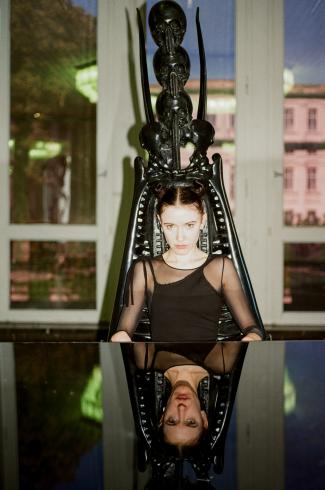The secrets of the exhibition with curator Agnes Gryczkowska | Exhibition Au-delà
Agnes Gryczkowska is an independent curator, writer, and musician.
She was formerly curator of Schinkel Pavillon, Berlin where she curated HR Giger & Mire Lee (2021); Sun Rise | Sun Set (2021) with works by Dora Budor, Max Ernst, Karrabing Film Collective, Max Hooper Schneider, Pierre Huyghe, Emma Kunz, Richard Oelze, Precious Okoyomon, Jean Painlevé, Pamela Rosenkranz, Rachel Rose, Henri Rousseau, Torbjørn Rødland, Ryuichi Sakamoto (amongst others) ; and the exhibition Claude Mirrors: Victor Man, Jill Mulleady, Issy Wood (2019). Gryczkowska also curated Amnesia Scanner: Anesthesia Scammer (2019) and Holly Herndon: PROTO (restaged) (2019) presented by Light Art Space at Kraftwerk, Berlin.
Prior to that, Gryczkowska was an artist and curator in residence at Somerset House, London and from 2015 to 2018, she was part of the curator team at Serpentine, London where she worked on exhibitions by Rachel Rose, Simon Denny, DAS INSTITUT (Kerstin Brätsch and Adele Röder), Marc Camille Chaimowicz, Wade Guyton, Grayson Perry, and Etel Adnan, amongst others.
Other recent curatorial projects include the group show Au-delà (2023) at Lafayette Anticipations, Paris and SuperFutures (2022) presented by Reference Studios, Berlin at Selfridges, London. She regularly writes quasi-fictional exhibition texts and has contributed to various contemporary art publications, including Spike and KALEIDOSCOPE.
Transcript
Hi, my name is Agnes Gryczkowska and I’m the curator of the Au-delà exhibition.
The exhibition Au-delà, Rituals for a new world is a show that is supposed to be itself a ritualistic journey, in a way transformative in itself hopefully and it takes us through different ceremonial and ritualistic practices beginning from some really ancient ones such as 2800 BC from the cycladic island to some contemporary ritualistic practices but also individual as well as collective rituals. So very much speaking of craftsmanship and this kind of idea of losing oneself in an activity of this kind of trance-like kind of practice. But also rituals are sacred but also pagan. Pagan in a way that they generate this link between us and the earth and speaking of this multiplicity of god and goddess and deities not of a single religious viewpoint.
What is important about the exhibition is that it really looks at different ritualistic practices in order to somehow respond to the moment we find are ourselves in nowadays where it almost seems as of this kind of necessity to go deeper into ourselves or transcend, it’s almost necessary in order to reach something sacred.
Perhaps in order to find some sublimity in day to day life again and also perhaps in order to be able to cope with the brutality of life.
What was also important for me was to bring together contemporary voices with some modern works but also with some ancient works so really kind of going deep into the layers of time in order to somehow look at how some ancient ritualistic practices some ancient ceremonial practices, the way that our ancestors saw the world, saw the humanity, saw the earth resonates very profoundly with the contemporary way of thinking, or should resonate more with the way we think now.
I think the topic of rituals was super important for me because first of all we seem to be losing those moments where we really are able to take a break, to dwell, to uphold also some sort of traditional values because rituals are, it’s a very broad topic because it speaks of traditions, it speaks of customs, it speaks of our little day to day activities, that can be collective but also very much individual. So beginning from little ritualistic practices that we all do everyday like tea drinking or just taking time to do a little face massage or simple things like this and also going to even bigger celebrations like posing and celebrating. I feel like people nowadays find it very difficult to actually get together and celebrate moments even though we seem to be so hyper connected.
